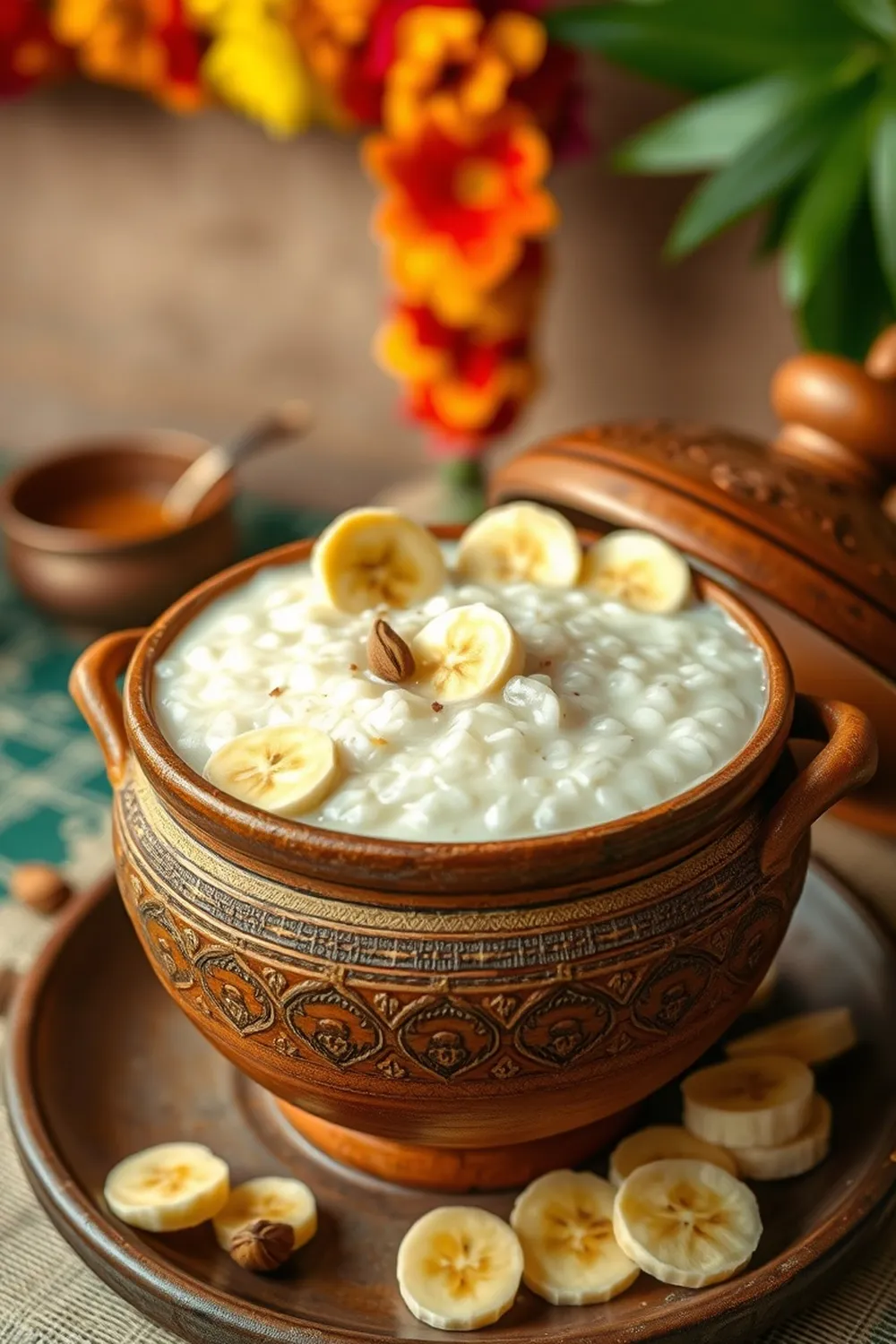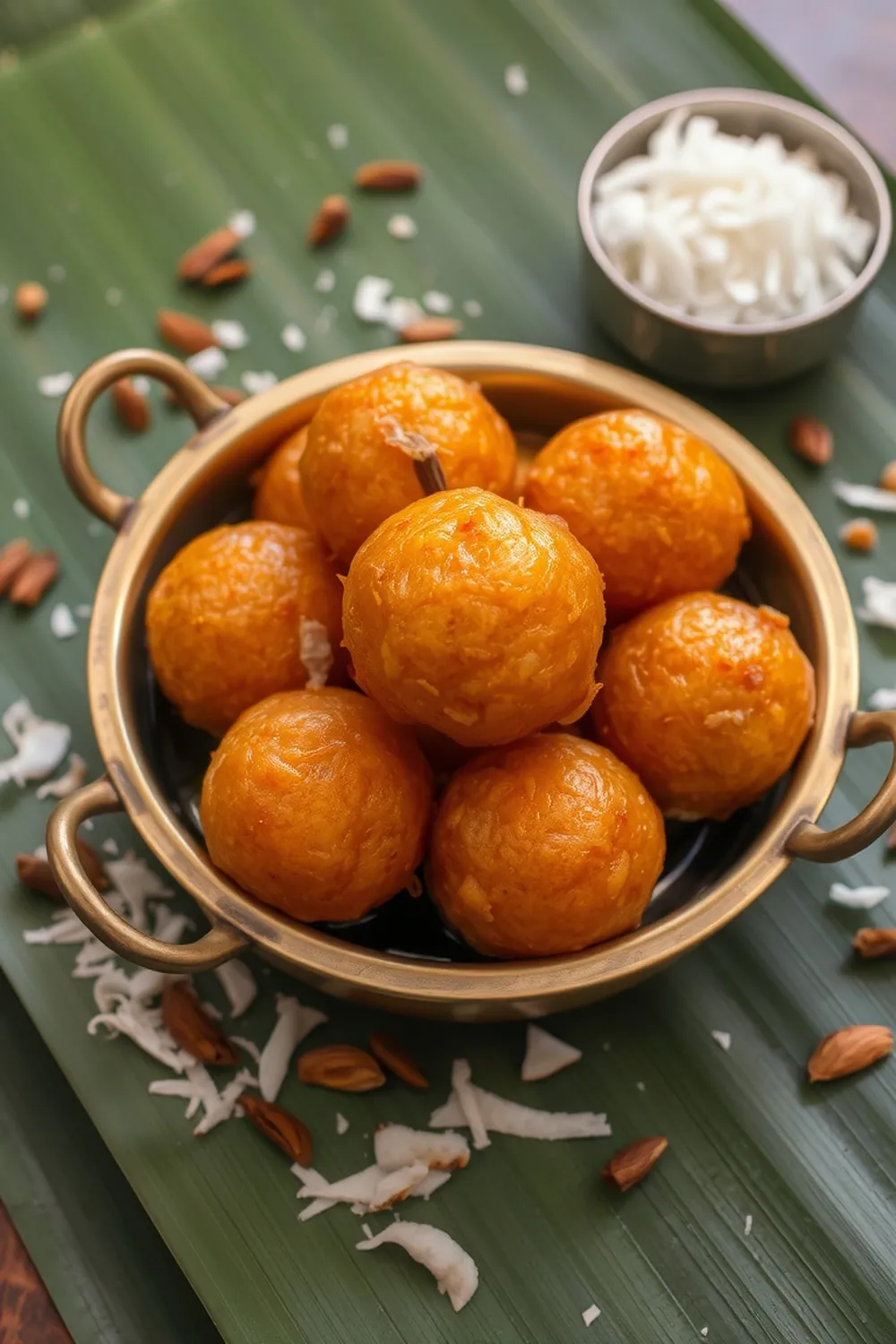- Heat 1 tsp ghee in a pressure cooker and roast 1/2 cup moong dal until aromatic.
- Add 2 cups water and pressure cook for 3 whistles until dal softens.
- Cool cooked dal and blend into a smooth paste.
- In a kadai, heat 2 tbsp ghee and roast 2 tbsp wheat flour until fragrant.
- Add blended dal paste to the kadai and cook for 5-7 minutes until thickened.
- Mix in 1/2 cup sugar and stir continuously until fully dissolved.
- Cook on medium flame for 10-15 minutes until mixture turns glossy.
- Add a pinch of saffron food color and cook on low flame for 5-10 minutes until halwa separates from pan.
- In a separate pan, roast cashews and raisins in 1 tbsp ghee until golden brown.
- Mix roasted nuts, raisins, and 1/4 tsp cardamom powder into halwa before serving.
- Calories:350 kcal25%
- Energy:1464 kJ22%
- Protein:8 g28%
- Carbohydrates:50 mg40%
- Sugar:30 mg8%
- Salt:15 g25%
- Fat:18 g20%
Last Updated on 3 months by Neha Deshmukh
Moong Dal Halwa Recipe – Traditional Indian Sweet with Wheat Flour
Introduction
Oh, halwa! Just the word conjures up images of festive gatherings, cozy winter evenings, and the sweet aroma filling the house. This Moong Dal Halwa is a classic for a reason – it’s unbelievably rich, comforting, and surprisingly satisfying. I remember the first time I attempted this; it took a couple of tries to get the texture just right, but trust me, the effort is absolutely worth it. It’s a bit of a labour of love, but the end result is a truly special dessert that’s perfect for celebrations or simply a sweet treat when you’re craving something truly delicious.
Why You’ll Love This Recipe
This isn’t just any halwa recipe. We’re adding a touch of wheat flour, which gives it a beautiful texture and a slightly nutty flavour that complements the moong dal perfectly. It’s a traditional recipe passed down through generations, and I’m so excited to share my version with you. It’s rich, decadent, and guaranteed to impress!
Ingredients
Here’s what you’ll need to create this delightful Moong Dal Halwa:
- 1 tsp ghee
- ?? cup moong dal (approximately 150g)
- 2 cups water (480ml)
- ?? cup ghee (approximately 115g)
- 2 tbsp wheat flour (approximately 15g)
- ?? cup sugar (approximately 150g – adjust to taste)
- Pinch of saffron food colour
- ?? tsp cardamom powder (approximately 1/2 tsp)
- 1 tbsp ghee
- 2 tbsp cashews (approximately 15g)
- 2 tbsp raisins (approximately 15g)
Ingredient Notes
Let’s talk ingredients! Getting these right will make all the difference.
Moong Dal: Type and Soaking (if any)
We’re using split moong dal (yellow moong dal) for this recipe. It cooks much faster than whole moong dal. No need to soak it beforehand – we’re pressure cooking it, which softens it beautifully.
Ghee: Importance of Quality & Clarified Butter vs. Regular Butter
Ghee is essential for that authentic halwa flavour. It adds a richness you just can’t get with regular butter. If you can, use good quality ghee. Clarified butter can be used as a substitute, but the flavour won’t be quite the same.
Wheat Flour: Using Whole Wheat vs. Refined Flour
I prefer using refined wheat flour (maida) for a smoother texture, but you can use whole wheat flour (atta) for a slightly healthier version. Just be aware that the whole wheat flour will give the halwa a slightly coarser texture.
Sugar: Regional Variations in Sweetness & Sugar Types
The amount of sugar is really up to your preference! Some people like their halwa very sweet, others prefer it more subtle. I’ve suggested around ¾ cup, but feel free to adjust. You can use granulated sugar, caster sugar, or even jaggery for a more traditional flavour.
Saffron Food Colour: Natural Alternatives & Colour Intensity
Saffron food colour gives the halwa that beautiful golden hue. If you prefer natural alternatives, you can use a pinch of turmeric powder, but be careful not to add too much, or it will affect the flavour. A few strands of real saffron soaked in warm milk will give the best colour and flavour, but it’s more expensive.
Cardamom: Freshly Ground vs. Store-Bought
Freshly ground cardamom is always best! The flavour is so much more vibrant. If you’re using store-bought cardamom powder, make sure it’s relatively fresh.
Cashews & Raisins: Roasting for Enhanced Flavour
Don’t skip roasting the cashews and raisins! It brings out their natural sweetness and adds a lovely crunch to the halwa.
Step-By-Step Instructions
Alright, let’s get cooking!
- Heat 1 tsp of ghee in a pressure cooker. Add the moong dal and roast for a minute or two until it smells fragrant.
- Add 2 cups of water and pressure cook for 3 whistles, or until the dal is completely soft and mushy.
- Once cooled, blend the cooked dal into a smooth paste. Set aside.
- In a kadai (or a deep frying pan), heat the remaining ghee. Add the wheat flour and roast on medium heat until it’s fragrant – about 5-7 minutes. Be careful not to burn it!
- Add the blended dal paste to the kadai and cook for about 5 minutes, stirring constantly, until the mixture starts to thicken.
- Now, add the sugar and continue stirring until it’s completely dissolved.
- Reduce the heat to medium-low and cook for about 15 minutes, stirring frequently, until the mixture turns glossy and starts to come together.
- Add a pinch of saffron food colour and cook for another 20-25 minutes on low heat, stirring continuously, until the halwa starts to leave the sides of the pan. This is the key to getting the right texture!
- While the halwa is cooking, in a separate pan, roast the cashews and raisins in 1 tbsp of ghee until golden brown.
- Finally, mix the roasted nuts and raisins into the halwa, along with the cardamom powder. Give it a good stir and serve hot!
Expert Tips
Let’s make sure your halwa is perfect!
Achieving the Perfect Halwa Texture
Patience is key! The longer you cook the halwa, the smoother and richer it will become. Don’t rush the process.
Preventing Sticking & Burning
Use a heavy-bottomed kadai to prevent sticking. And stir, stir, stir! Constant stirring is crucial, especially towards the end of the cooking process.
Roasting Techniques for Optimal Flavour
Roasting the dal and the nuts really elevates the flavour. Don’t skip these steps!
Variations
Want to put your own spin on things? Here are a few ideas:
Vegan Moong Dal Halwa
Substitute the ghee with coconut oil or vegan butter. It won’t have the exact same flavour, but it will still be delicious!
Gluten-Free Moong Dal Halwa (Alternative Flours)
Use almond flour or besan (gram flour) instead of wheat flour.
Spice Level Adjustment (Adding More Cardamom or Other Spices)
Feel free to add a pinch of nutmeg or a dash of cinnamon for a warmer flavour.
Festival Adaptations (Holi, Diwali, Weddings)
This halwa is perfect for any celebration! You can garnish it with edible silver leaf (varak) for a more festive look.
Serving Suggestions
Serve hot, garnished with extra nuts and a sprinkle of cardamom. It’s delicious on its own, or with a scoop of vanilla ice cream.
Storage Instructions
Store leftover halwa in an airtight container in the refrigerator for up to 3-4 days. Reheat gently before serving.
FAQs
Got questions? I’ve got answers!
What is the best type of moong dal to use for halwa?
Split yellow moong dal is the best choice – it cooks quickly and gives a lovely smooth texture.
Can I make this halwa without a pressure cooker?
Yes, you can! Just boil the moong dal in a pot with plenty of water until it’s very soft and mushy. It will take longer, though.
How do I know when the halwa is cooked to the right consistency?
The halwa should start to leave the sides of the pan and come together as a cohesive mass. It should also have a glossy sheen.
What can I substitute for ghee in this recipe?
Coconut oil or vegan butter can be used, but the flavour will be different.
How can I prevent the halwa from becoming grainy?
Cook it on low heat and stir constantly. Don’t rush the process!
Can this halwa be made ahead of time?
Yes, but it’s best enjoyed fresh. The texture can change slightly upon reheating.
Is it possible to adjust the sweetness level in this halwa?
Absolutely! Start with ¾ cup of sugar and add more to taste.










